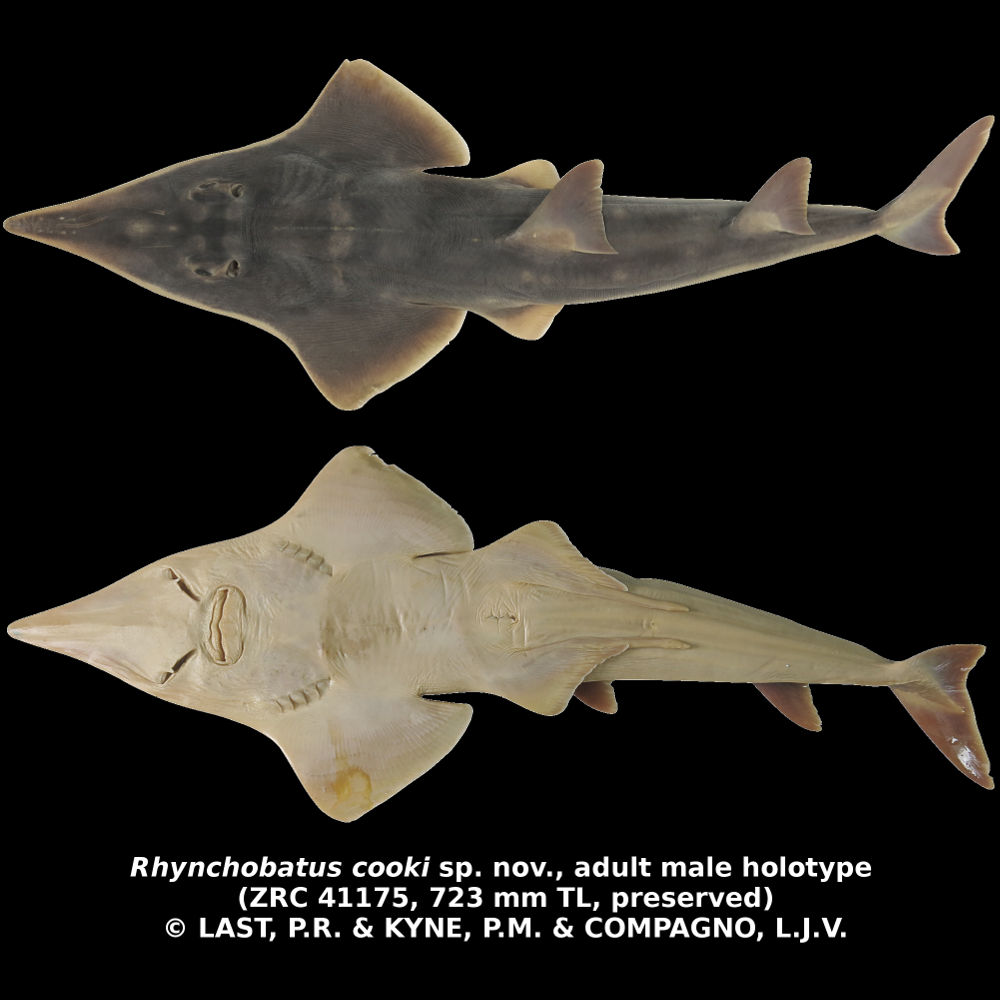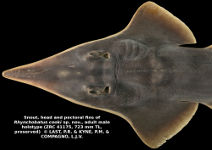Rhynchobatus cooki
Last, Kyne & Compagno, 2016
Clown Wedgefish
Classification: Elasmobranchii Rhinopristiformes Rhinidae
Reference of the original description
A new species of wedgefish Rhynchobatus cooki (Rhinopristiformes, Rhinidae) from the Indo–West Pacific. Zootaxa, 4139(2), 233–247
A new species of wedgefish Rhynchobatus cooki (Rhinopristiformes, Rhinidae) from the Indo–West Pacific. Zootaxa, 4139(2), 233–247
Synonyms / new combinations and misspellings
Rhynchobatus compagnoi
Rhynchobatus compagnoi
Types
Rhynchobatus cooki
Holotype: ZRC: 41175; Paratype: BPBM: 19673; CAS: 13952; CAS: 35592; SAM: F039829; ZRC: 41173; ZRC: 41174;
Rhynchobatus cooki
Holotype: ZRC: 41175; Paratype: BPBM: 19673; CAS: 13952; CAS: 35592; SAM: F039829; ZRC: 41173; ZRC: 41174;
Description :
Citation: Rhynchobatus cooki Last, Kyne & Compagno, 2016: In: Database of modern sharks, rays and chimaeras, www.shark-references.com, World Wide Web electronic publication, Version 12/2025
Please send your images of "Rhynchobatus cooki" to info@shark-references.com

Rhynchobatus cooki sp. nov, adult male holotype (ZRC 41175, 723 mm TL, preserved) © Last, P.R. & KYNE, P.M. & Compagno, L.J.V.

Rhynchobatus cooki sp. nov, adult male holotype (ZRC 41175, 723 mm TL, preserved) © Last, P.R. & KYNE, P.M. & Compagno, L.J.V.
Common names
 Clown Wedgefish
Clown Wedgefish
 Clown Wedgefish
Clown Wedgefish
Short Description
Original diagnosis after LAST, KYNE & COMPAGNO, 2016 [24320]: A dwarf species of the genus Rhynchobatus (adults to 81 cm TL) with the following combination of characters: a very long, narrowly pointed snout, preoral snout 21–25% TL; eye small, length 5.1–6.6 in preorbital snout; interorbital space 3.2–4.0 in preorbital snout; mouth weakly bowed, with a strong indentation on upper jaw near symphysis and strong protuberance on lower jaw; tooth rows in upper jaw 32–39; two irregular rows of small rostral spines on distal third of snout, almost extending to snout tip but not distinctly paired; supraorbital spines small but well differentiated, discontinuous (present only on preorbit and beside spiracle); mid-dorsal spine row broken but well-developed in adults; only a few small scapular spines on shoulder (often obscure); origin of first dorsal fin slightly posterior to origin of pelvic-fin base; predorsal length 47–51% TL; colour dark greyish green above (when fresh) with variable pattern of white spots (not arranged in rows), juveniles more densely covered with large white blotches; dark cruciate marking on interorbital but no black pectoral marking; anterior pectoral disc and sides of tail with a broad white margin; a few dark transverse bars forward of dorsal fins; 66–72 precaudal free centra, 99–106 total free centra, 112–119 total centra (including synarcual centra); 48–52 total pectoral-fin radials.
Original diagnosis after LAST, KYNE & COMPAGNO, 2016 [24320]: A dwarf species of the genus Rhynchobatus (adults to 81 cm TL) with the following combination of characters: a very long, narrowly pointed snout, preoral snout 21–25% TL; eye small, length 5.1–6.6 in preorbital snout; interorbital space 3.2–4.0 in preorbital snout; mouth weakly bowed, with a strong indentation on upper jaw near symphysis and strong protuberance on lower jaw; tooth rows in upper jaw 32–39; two irregular rows of small rostral spines on distal third of snout, almost extending to snout tip but not distinctly paired; supraorbital spines small but well differentiated, discontinuous (present only on preorbit and beside spiracle); mid-dorsal spine row broken but well-developed in adults; only a few small scapular spines on shoulder (often obscure); origin of first dorsal fin slightly posterior to origin of pelvic-fin base; predorsal length 47–51% TL; colour dark greyish green above (when fresh) with variable pattern of white spots (not arranged in rows), juveniles more densely covered with large white blotches; dark cruciate marking on interorbital but no black pectoral marking; anterior pectoral disc and sides of tail with a broad white margin; a few dark transverse bars forward of dorsal fins; 66–72 precaudal free centra, 99–106 total free centra, 112–119 total centra (including synarcual centra); 48–52 total pectoral-fin radials.
Distribution
Specimens obtained from the Jurong fish market (Singapore) and a Jakarta fish market (probably Muara Angke) (Indonesia). Also observed at Muara Angke fish market (Jakarta, Indonesia) in the early 1990s. Fishers landing product at these markets operate widely across the Indo–Malay Archipelago so the providence of specimens are unknown. For example, fish landed at Jurong are unlikely to be from Singaporean waters, but may be from the South China, Java or Andaman Seas [24320] Source: www.gbif.org
Specimens obtained from the Jurong fish market (Singapore) and a Jakarta fish market (probably Muara Angke) (Indonesia). Also observed at Muara Angke fish market (Jakarta, Indonesia) in the early 1990s. Fishers landing product at these markets operate widely across the Indo–Malay Archipelago so the providence of specimens are unknown. For example, fish landed at Jurong are unlikely to be from Singaporean waters, but may be from the South China, Java or Andaman Seas [24320] Source: www.gbif.org
Size / Weight / Age
at least 810 mm TL; embryos with yolk sacs were 209 and 236 mm TL, a male 395 mm TL was juvenile, a male 642 mm TL was adolescent, and six males >705 mm TL were adult; females 415 and 609 mm TL were immature.[24320]
at least 810 mm TL; embryos with yolk sacs were 209 and 236 mm TL, a male 395 mm TL was juvenile, a male 642 mm TL was adolescent, and six males >705 mm TL were adult; females 415 and 609 mm TL were immature.[24320]
Dentition
Teeth in differentiated serial rows, ~39 (32–39) in upper jaw, ~34 (33–39) in lower jaw [24320]
Teeth in differentiated serial rows, ~39 (32–39) in upper jaw, ~34 (33–39) in lower jaw [24320]
Remarks
shark-references Species-ID=14614; CITES: (see: Protected Species for more details) Convention on International Trade in Endangered Speciesof Wild Fauna and Flora annex: II; Council Regulation 2017/160 annex: B
shark-references Species-ID=14614; CITES: (see: Protected Species for more details) Convention on International Trade in Endangered Speciesof Wild Fauna and Flora annex: II; Council Regulation 2017/160 annex: B


















